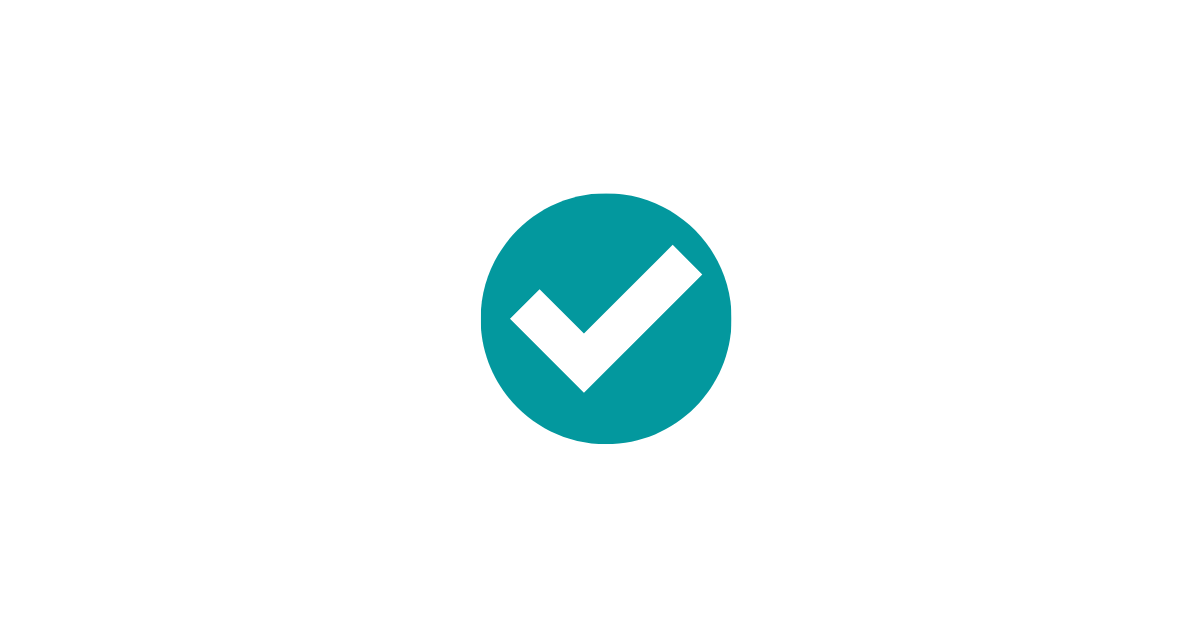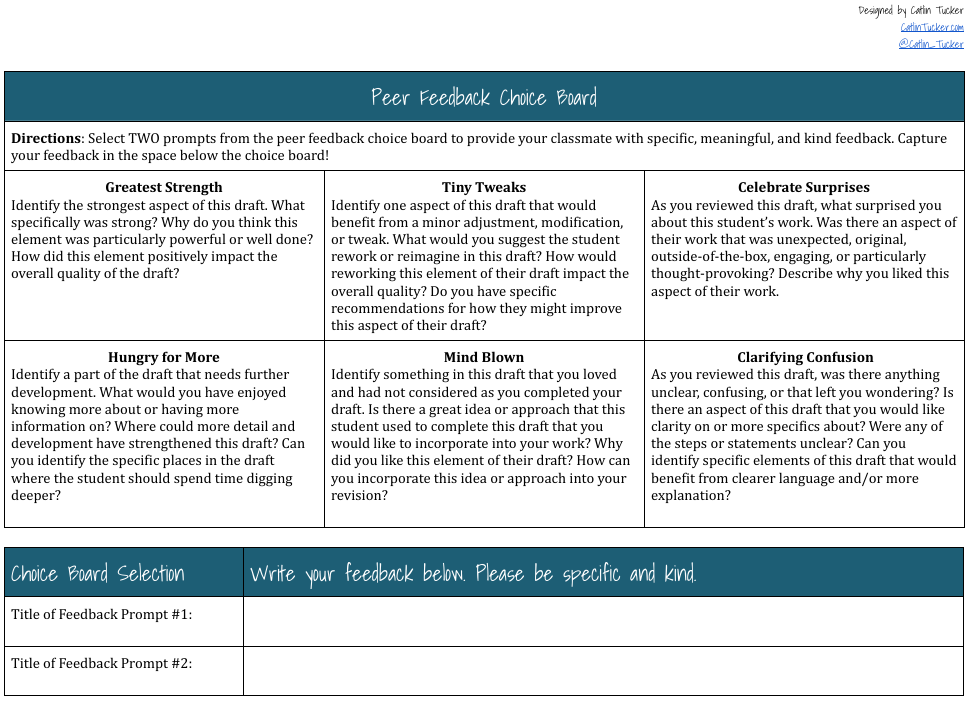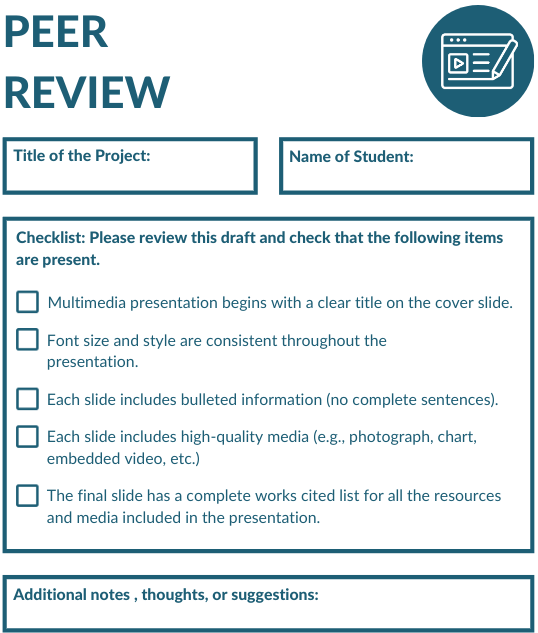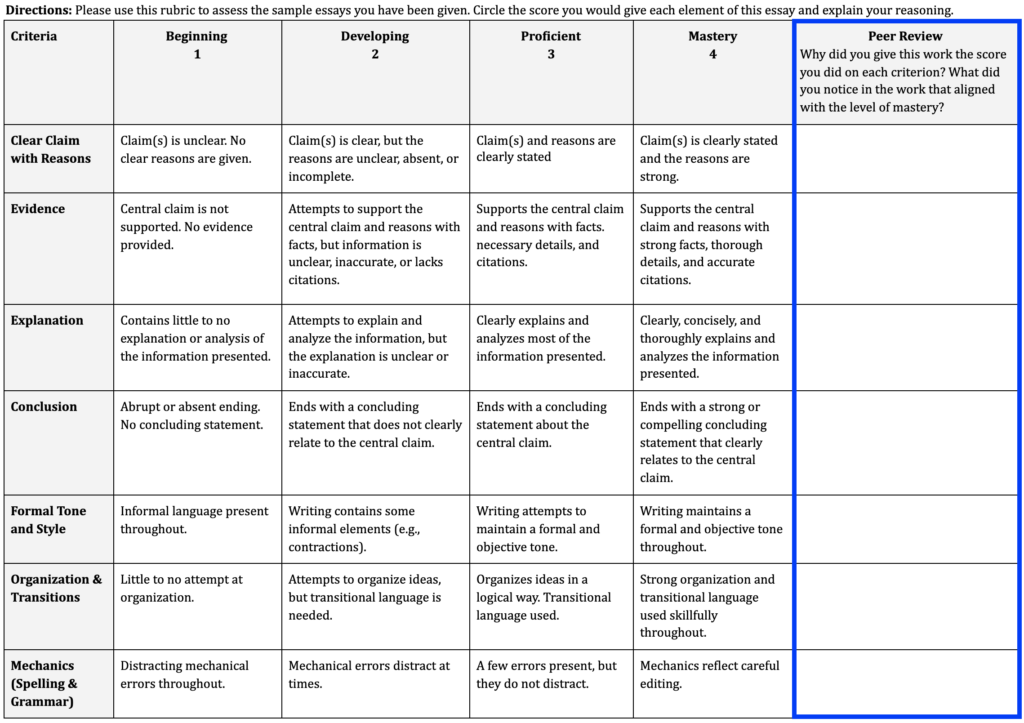Feedback is how students feel seen and supported. It is also how we communicate to our students that we value the process over the product. When we give feedback as students work, we signal that the work they are doing is important, and we care about their progress.
Teachers want to give students timely, focused, and actionable feedback, yet it is easy to neglect. Traditional approaches to providing feedback are time-consuming and often require hours of work beyond the school day. Given the pressure on teachers, I’ve been working on strategies to help support students in giving each other feedback. As a learning community, all members should play a role in providing thoughtful and substantive feedback.
Peer feedback is most effective when it is focused, and students have clear guidelines for giving feedback. Below are three strategies designed to make peer feedback meaningful.
Peer Feedback Choice Board
Choice is a powerful motivator. Giving students meaningful choices can help them to successfully complete tasks. So, why not use this format for peer editing? Building student agency into the peer feedback process removes barriers and encourages students to provide feedback through a specific lens. Based on what a student sees in the work they are reviewing, they may be drawn to one option on the choice board over another.
Teachers working with younger students or second language learners can create a choice board with sentence frames to provide students with additional support as they give each other focused feedback. For example, under the box labeled “Greatest Strength,” teachers could rework that as a series of fill-in-the-blank statements. The strongest part of this draft was ________. I thought _______ was done well. I really liked _____. Each option in the choice board could be composed of fill-in-the-blank statements that students complete. This approach to designing a choice board for peer feedback gives students agency and choice while providing the necessary scaffolding to make this activity accessible.
Assignment Checklist
It is challenging to “see” our own mistakes, but another student can provide a set of fresh eyes. Before submitting a finished product, teachers can provide students with a checklist of items required in the work. These are often the same things that teachers outline in the initial description of the assignment, task, or project. For example, English teachers may have expectations around font size and type, spacing, indentation, quotes, and citations. As students move through the writing process, they may forget some of these requirements and benefit from a peer editor who can review their work to ensure it complies with the stated guidelines for the assignment.
When using a checklist to guide peer feedback, I recommend the following:
- Pair students strategically
- Articulate the value of peer feedback
- Review the expectations and format for peer feedback with the class
- Give students time in class to provide each other with peer feedback
- Limit the number of items on the checklist to avoid overwhelming students
- Encourage students to make notes on the checklist identifying gaps, missing elements, formatting errors, etc. but to avoid making notes on the other student’s work
The checklist approach is designed to help students clean up easy-to-correct mistakes before submitting their work. The peer reviewer should not make any edits for the other person. Instead, they should identify areas where the student will need to spend time editing or developing their work.
Peer Review Using Rubrics
Rubrics are like roadmaps. They provide clarity about what students are working toward. I believe rubrics should be provided at the start of any assignment, task, or project that will be assessed using a rubric. That way, students can reference the rubric as they work.
If teachers create a standards-aligned rubric that includes descriptions for what the individual skills “look like” on a scale of 1 (beginning) to 4 (mastery), students can use a modified version of that rubric to give peer feedback in the form of an informal assessment. Teachers can add a column to their rubric that encourages students to provide a brief explanation for each score they give their partner.
This approach has the added benefit of helping students get familiar with the rubric that the teacher will use to assess their finished products. As they read the language on the rubric and evaluate their peer’s work, they may realize that aspects of their own work need development or revision.
These peer feedback strategies can be used individually or in combination to provide ongoing support at different stages in the process. Peer feedback aims to engage the learning community in the process of thinking about the work they are doing and supporting each other. These activities position students at the center of the learning and require that they think critically about each other’s work. These peer feedback routines can also lighten the load for teachers. This is because they are no longer the only source of high-quality feedback in the classroom.
Leaders looking to support teachers with self-paced online learning opportunities this summer can request a quote for my Getting Started with Blended and Online Learning and my Advancing with Blended and Online Learning courses!





36 Responses
I attended the online course in BL. Keen to attend more courses.
Im excited to learn the rubrics different styles, Im anxious to have students grade their own or their peers , with the use of rubrics. it will be a great learning opportunity for self management.
I’ve incorporated peer review on and off for my ELA classes for many years. I’ve tried using it with my Speech class (using rubrics and orally) with some success and other failures. It often depends on the group of students. Teaching this past year online has been especially challenging. I clearly modeled the feedback as the semester began and throughout, but even after encouraging critical feedback from peers – aside from the two or three that always supply positive feedback and support – it’s like the old Looney Toons cartoon where Daffy tries to outdo Bugs on the stage doing these incredible antics and ending with a “Ta-Da!!”, only to hear a few crickets in the audience. Any suggestions for peer feedback in an online class where students are giving presentations (some live, some filmed) and they are very hesitant?
Hi Jonathon,
Giving feedback online can be a bit more challenging. That said, I’ve had success with students completing Google Forms with feedback. When they submit it, you can collect their names. However, when you share the spreadsheet with the class, I would remove the reviewer’s name, so only the feedback is visible. I have used that strategy with my high school students and now with my graduate students. That might make them more comfortable giving honest and specific feedback.
I also really love using FlipGrid for video feedback. I’ve asked students to describe their approach or walk the class through a project. Then they can record feedback for each other. That isn’t anonymous, but it can make students feel connected to a learning community online when they are physically distant from each other.
Hopefully, other folks can jump in with ideas and suggestions!
Take care.
Catlin
Hello Catlin,
First I would like to say I love choice boards. This year I have implemented the use of choice boards in my freshman Earth Science course.
I have always used rubrics, however it never occurred to me to use a choice board for peer feedback. I love this idea and plan on including it in my lesson plan for the upcoming school year. With that said I also want to thank you for your suggestions on how to incorporate this into virtual learning.
You’re welcome, Martha! I’m thrilled my blogs and resources have been helpful as you work with kids online!
Catlin
Hi Catlin
Love the choice feeback board. I’ve stumbled into teaching for the first time, and online just when the pandemic lockdowns started. I’m collaborating with another educator and I’m loving it. I’m going to look at more of your resources for blended learning, as I’m more anxious about live classroom teaching than online – I know – bizarre. But been fairly introverted it does play to my strengths. I’m also aware that I need to provide body /environmental experience exercises…. and give feedback too.
Thanks for all this work
You’re welcome, Cathy! I can imagine the anxiety of shifting into a physical learning environment when you have gotten comfortable online. Hopefully, many of the strategies you’ve honed online can transition fluidly into the physical classroom. My goal when working with teachers is to help them develop a flexible skill set since blended learning models work so well in class, online, or a blend of the two!
I hope my blogs will be a useful resource! I also have two online self-paced courses focused on blended learning if you need additional support.
Take care!
Catlin
With most of my students being on zoom they do not want to share with their fellow classmates. I have some leave ( a lot) when it was time. Therefore , I make sure I leave clear and understandable based on their language skills praise, revision ideas on what needs to be fixed.
Good Morning Dr.Tucker
Thank you for your never ending ideas and resources to help students and teachers. Could you provide copies of the templates in this post? I would like to use them and pass them on to fellow staff members.
Thank you so much
Jeff
Hi Jeff,
The images are linked to the resources. Just click the picture of the resource you want and it will open in a new tab. You can click “File” on the Google Documents and select “Make a copy” to save an editable version to your Google Drive in case you or other teachers want to modify them.
Take care!
Catlin
Hi Caitlin
Sorry to be a bother- when I click on the resources, they are screen shot pngs-not google docs. Is there a way to transfer them so I can share? Thank you again for your time.
Jeff
Hi Jeff,
Sorry about that! I had originally linked the images to the documents, but it seems like there was an issue. I’ve added a clickable link below each image so you can either copy or access.
Take care.
Catlin
Hi Dr. Tucker,
Thank you so much for the work you do! I think these images are still png files. Do you have the google docs versions available? THank you again!
Hi Anthony,
I’ve added a clickable link below each image so you can either copy or access.
Take care.
Catlin
Thanks for these clear, varied and organized options. Like Jeff, I’m hoping to make copies via Google as you suggest; however, when I click on the images, they open as screenshots instead of opening as Google Docs. You’ve been a invaluable resource to me all year!
Hi Alicia,
I’m thrilled I can be a resource for you! I’ve added a clickable link below each image so you can either copy or access.
Take care.
Catlin
I LOVE the peer feedback choice board! Students often struggle with what type of feedback to give and this board scaffolds that for them. I appreciate the suggestions for adjusting the board for younger students and second language learners. The sentence frames really lay out a pathway for thinking and feedback – elementary friendly! I also like the last peer review rubric. In our division we are working with teachers on single point rubrics. I can see using this with the proficient column, a self reflection column and the peer review column. Thank you for sharing these examples!
You’re welcome, Jennifer! I’m so glad these resources are useful.
Take care.
Catlin
Yes yes yes to all of this, as usual. One obstacle I run into when assigning peer feedback is students’ discomfort with correcting each other. Even if they can see simple errors, they often won’t correct them, fearing the originator will be upset, mad, or feel shamed. I’m currently dealing with this issue by creating Google Doc forms that I then copy to make anonymous and deliver to the originator. I’d love other suggestions for combatting this phenomenon.
Hi Molleen,
I can understand the hesitation to make corrections since students are not always confident about their corrections or worry about how the other students will receive the feedback. It may be more comfortable for them to highlight the areas that need correcting so the person who did the work can do the actual corrections. I have used a similar strategy with anonymous feedback using Google Forms and sharing the spreadsheets with students, but it is time-consuming.
The best way to “normalize” feedback is to be really clear about the purpose and value, provide a clear strategy for giving feedback, and build feedback into our work in class with students. One of my favorite strategies for giving feedback is using the teacher-led station (in a station rotation lesson) to give focused, actionable, real-time feedback as students work. The more informal feedback they receive from their teachers and peers, the more they begin to appreciate the value of feedback on their growth. The whole process becomes a natural part of class over time.
Hopefully, other folks can chime in with their thoughts on streamlining feedback and addressing student discomfort with giving feedback.
Catlin
Reading through this caused me to think about how this can be applied for peer review for us as Teachers. Many of the points are absolutely applicable especially because this type of process is so much more difficult to implement because adults bring an lifetime of experiences.
I also like the Peer Review Choice Board. Blended learning has certainly come into its own as have we who have had to adapt and adjust. It has also increased educator comfort level with this approach. I like to think of it as a challenge that presented us with an opportunity.
I absolutely love the Peer Feedback Choice Board idea! My students struggle with making constructive and meaningful peer review/evaluation. I think a choice board will help dramatically.
This is super comprehensive and valuable.
Thank you Catlin for sharing! Peer evaluation and feedback is a great feature and a usual closure in my PYP classroom.
Your resource will be a great addition to my library this time.
Regards
Kanchan
Kanchan
You’re welcome, Kanchan!
I appreciate all what you do for us teachers, and I want to tell you that this is my last year teaching, I will retire!
The information is very informative, I wish I had it last year as I am retiring. I believe it would be extremely helpful to future and current teachers.
Thank you, Joseph!
I appreciate the information as well as the helpful information. Thank you.
Thank you for sharing. I will apply this new knowledge in my classroom. Thanks again.
You’re welcome, Jorge!
Take care.
Catlin
The information is helpful, but since I will retire I am this G.T. course because is a requirement this year
I like the choice board. It’s good to have choices at times.
I feel rubrics are very useful in writing assignments in order to train students to proofread their work and make corrections before submitting any assignment. It also helps them be aware of exactly what the teacher is looking for and what they need to accomplish in order to receive a good score.
Love your choice board! Thank you for sharing!
You’re very welcome, Jenn! I’m so happy it’s helpful.
Have a wonderful start to the school year!
Catlin